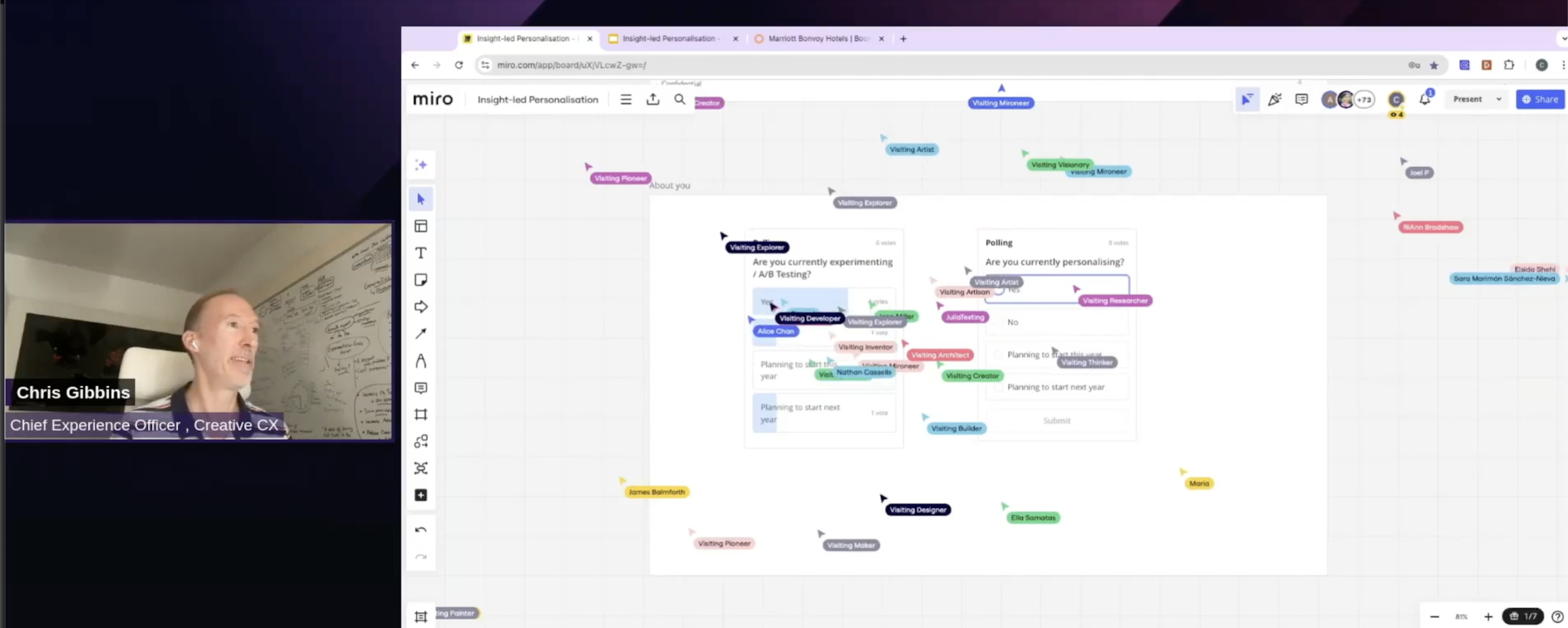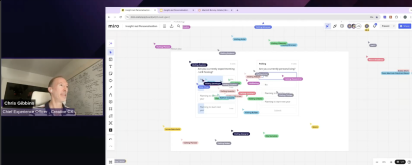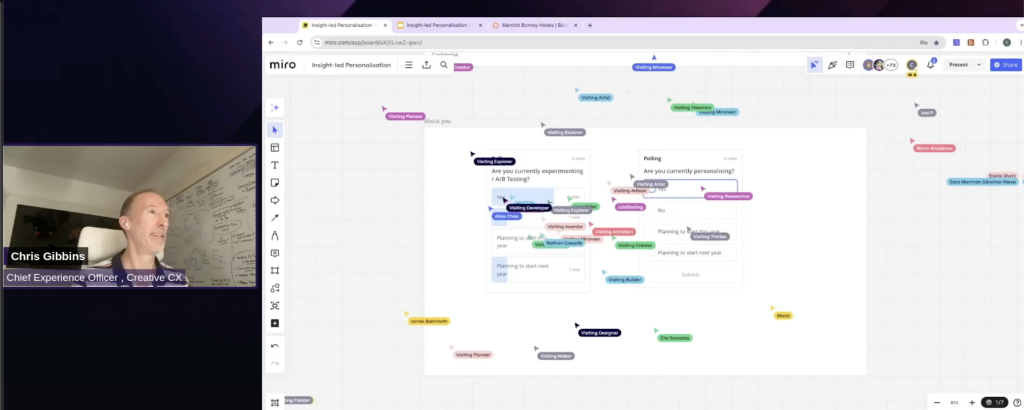
As we bring our VWO CONVEX 2024 recap series to a close, we’ll be highlighting actionable insights and proven strategies from Chris Gibbins’ workshop on ‘Insights-led Personalisation.
Over the course of the series, Chris has shared invaluable expertise – from interviewing Primark’s Digital Optimisation Lead, Annette Rowson, Easyjet’s CRO Manager, Vicky Routley.
If you’ve missed the earlier recaps, make sure to check them out!
Why Personalise?
Chris kicked off the workshop by explaining why personalisation is important.
While personalisation is often associated with marketing and ads, where the goal is to push tailored messages to specific audiences, its true value extends far beyond that.
Personalisation plays a critical role in enhancing the overall customer experience, ultimately leading to improved business performance.
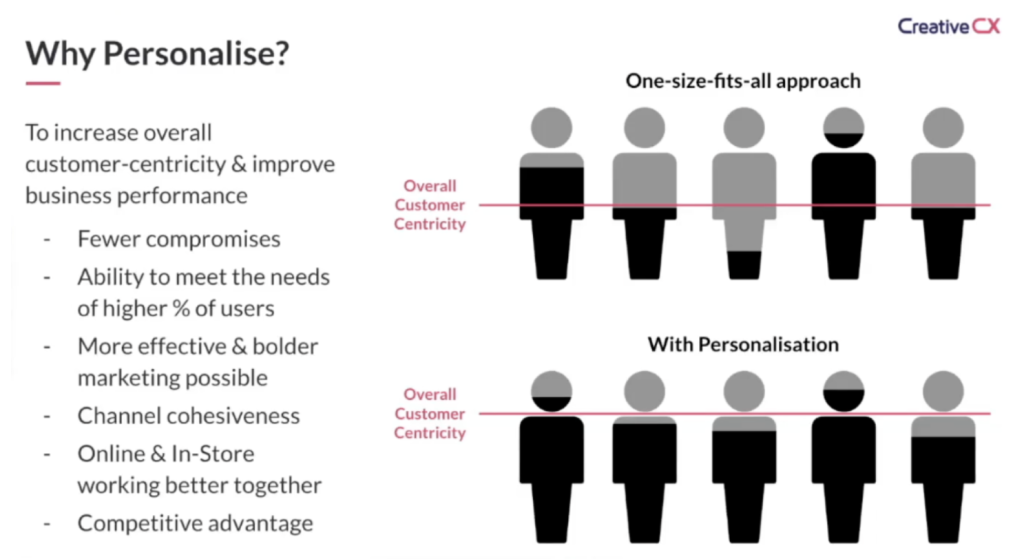
While a “one-size-fits-all” approach can work at a higher level, it requires compromises that may benefit some groups but fall short for others.
Personalisation allows us to move beyond these trade-offs by creating tailored experiences for key user groups.
This shift not only reduces compromises but also boosts customer satisfaction by addressing the unique needs of a larger audience.
Personalisation encourages bolder, more targeted marketing. When you know exactly who you’re marketing to, you can make more impactful and specific offers, rather than crafting generic messages aimed at everyone.
This ability extends across all channels, enabling a seamless connection between online and in-store experiences, which ultimately drives competitive advantage.
Personalisation Reminders
It’s important to remember that delivering effective personalisation doesn’t mean skipping the rigour of good experimentation practices.
Chris emphasised during the workshop: “It’s amazing how many people I speak to that, when it comes to personalisation, forget about A/B testing everything they’re personalising.”
To ensure your personalisation efforts are grounded in solid experimentation principles, here are the reminders:
Conduct Discovery Research and Analysis: Start by identifying opportunities for personalisation through discovery research. Focus on uncovering contrasting needs and behaviours among key audience groups. As with A/B testing, your analysis should lead the way in pinpointing the areas where personalisation can make the biggest impact.
Solve Genuine Problems: Personalisation only works when addressing a real problem and significant differences in needs, motivations, or behaviours between different audiences. If there’s no notable difference, there’s no point in personalising.
Define Problem Statements and Hypotheses: Before launching a personalisation campaign, ensure you have a clear problem statement and hypothesis. While it might sound obvious, Chris noted how often personalisation initiatives lack a defined hypothesis, making it difficult to measure their success or alignment with user needs.
Always Test Against a Control: Never skip the step of testing your personalised experiences against a control. This ensures that your efforts are not only effective, but also grounded in measurable outcomes.
These reminders are straightforward, but important.
As Chris highlighted: “The bigger the difference in user needs, motivation, and intent, the bigger the opportunity for personalisation.”
Without these contrasts personalisation becomes pointless. By focusing on discovery and experimentation, you can ensure that your personalisation initiatives deliver real value to your users and your business.
Personalisation Themes
Chris also shared that personalisation is often misunderstood and can take on different meanings, frequently being perceived as tool-driven, quick-win tactics.
However, he emphasised that the most impactful personalisation comes from being insights-led, truly understanding customers, and adopting a customer-centric approach.
To illustrate this, Chris explored several key themes in personalisation:
Session Continuation: A particularly fitting approach for mobile users, session continuation focuses on helping customers pick up where they left off. Don’t make users start from scratch. Many users don’t complete purchases in a single visit – they’re browsing on the go, distracted by their environment, or simply not ready to buy. Personalisation can make it easier for users to continue their journey seamlessly without starting all over again.
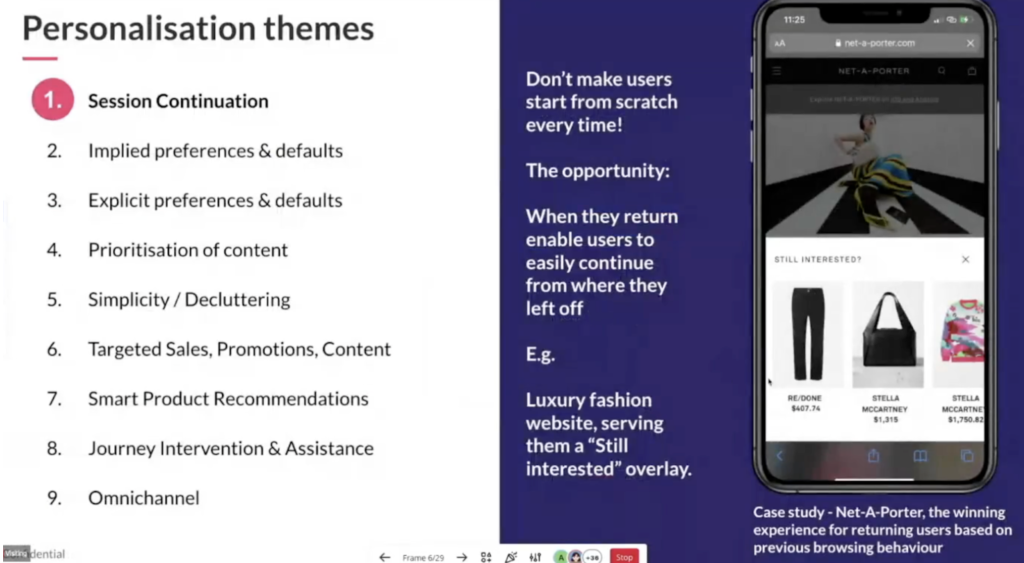
For example, Chris highlighted an experiment with a fashion brand that implemented a “Still Interested?” pop-up displaying previously viewed items when users returned to the site. This approach reduces friction and keeps users engaged, particularly in multi-session journeys.
Implied Preferences and Defaults: Implied personalisation involved tailoring experiences based on user actions. For example, if a user consistently sorts a listings page by price from low to high, personalisation can automatically apply that preference. By learning from user behaviours, brands can remove unnecessary steps, creating a smoother journey that aligns with individual preferences.
Explicit Preferences and Defaults: Explicit personalisation, on the other hand, relies on users providing information directly.
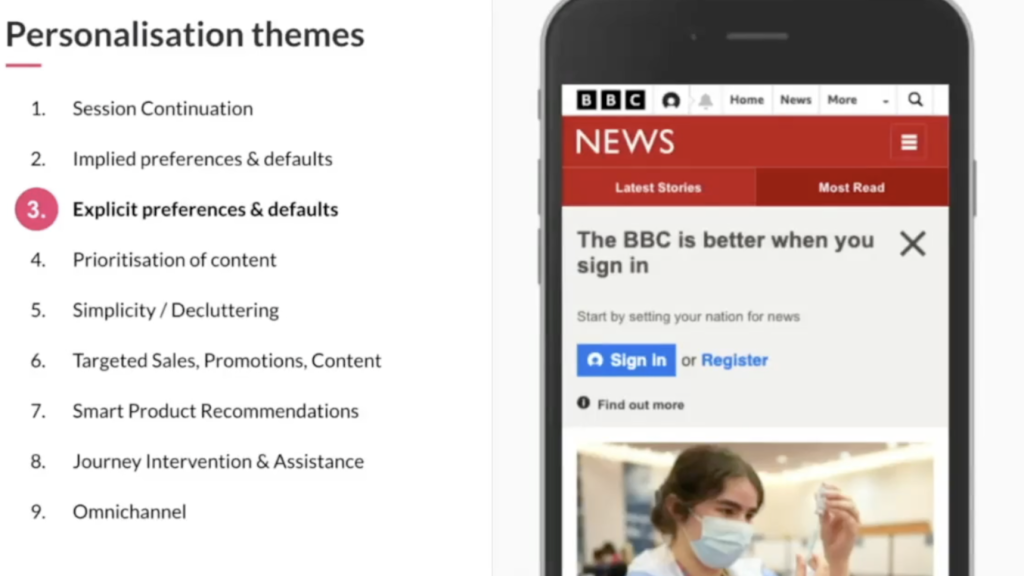
For example, a platform like the BBC might prompt users to sign in and select preferences, such as identifying as a business user. Explicit preferences allow brands to be transparent and precise in meeting user needs, creating trust and improving relevance.
Prioritisation of Content: The order of content on a page significantly impacts user interaction. Using insights from implied preferences, brands can prioritise content that aligns with user interests, such as displaying price-sensitive items higher on the page for budget-conscious users.
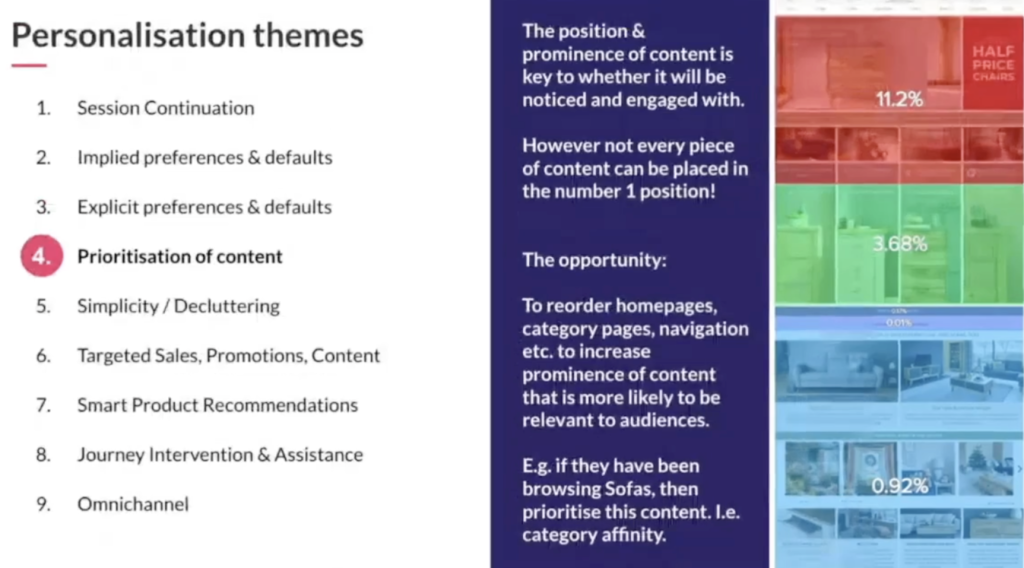
This approach can increase engagement and improve the performance of landing pages and other touchpoints.
Simplicity and Decluttering: A common challenge for many brands is managing excessive content on their website. Personalisation provides an opportunity to declutter and remove irrelevant information for specific users, streamlining the experience and improving usability.
Targeted Sales, Promotions, and Content: One of the most familiar uses of personalisation is crafting targeted messages for specific audiences. Rather than using a one-size-fits-all approach, brands can tailor promotions and content to resonate more deeply with particular user groups, leading to stronger and more effective communication.
Smart Product Recommendations: Product recommendations are perhaps the most recognised form of personalisation, but they can be much more strategic than simply deploying a recommendation tool.
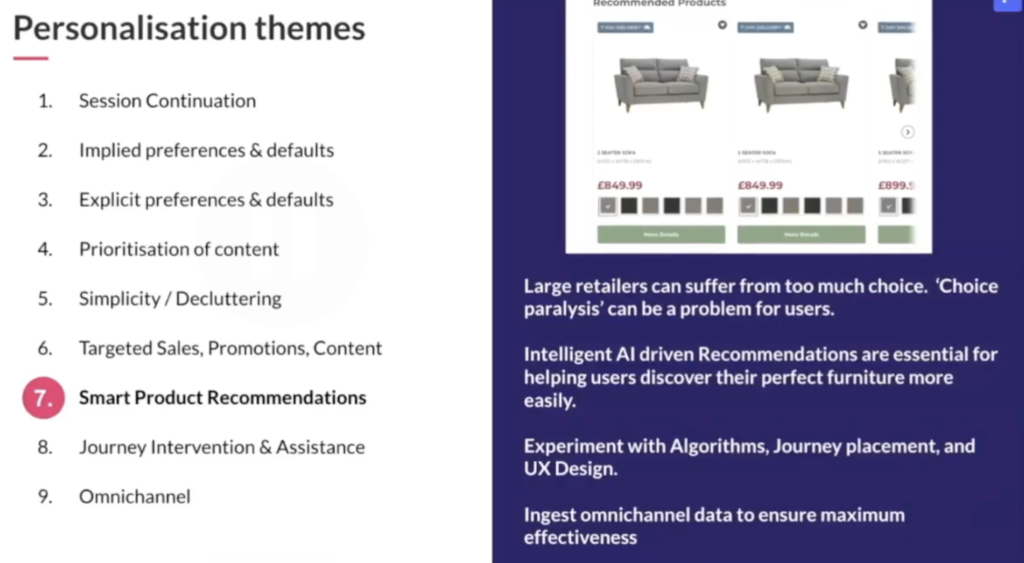
For example, Chris discussed optimising the placement of recommendations for users arriving via Google Shopping. These users are often in comparison mode and may not be familiar with your brand, so prominent and well-placed recommendations can keep them engaged and reduce bounce rates.
Omnichannel Personalisation: Personalisation doesn’t stop at digital – it extends across the entire customer journey. Chris discussed the opportunities for connecting online and in-store experiences, such as QR code journeys that bridge digital and physical interactions. By doing this, brands can use personalisation to support customers conducting research online before visiting a store, tailoring the online experience to complement their in-store journey.
These themes highlight the many ways personalisation can enhance user experiences when approached with insight and strategy. By focusing on customer needs and leveraging both implied and explicit data, brands can create more meaningful, effective interactions.
Interactive Exercise: Personalisation in Action
To bring the workshop to life, Chris guided the group through an interactive exercise using a hotel website as an example. While not based on a Creative CX client, the site was representative of many similar hotels in the industry, making it an accessible scenario for participants of all stages in experimentation.
Step 1: Identify Key Audiences
The first step in crafting a personalisation strategy is pinpointing key audience groups – those with the most contrasting needs and behaviours.
Chris explained that this process involves stakeholder interviews, data analysis, and reviewing existing research. Often, businesses already have a good sense of their distinct audience groups, and the goal is to confirm and refine these insights.
For this hotel site example, Chris outlined three audience pairings with contrasting needs:
Guests without children vs Families with children:
- Families often struggle to find rooms accommodating children, with connected rooms and child-friendly facilities ranking high on their priority list. Buffet breakfast options also stood out as a need due to kids’ fussy preferences.
- On the other hand, guests without children, particularly business travellers, values features like desks for working and reliable Wi-Fi. Many were put off by too many images features children, highlighting how visuals can influence user perception.
Existing reward members vs. Non-members:
- Reward programme members were highly motivated by points, with perks like free reward nights being a significant driver, especially for business travellers. Data revealed that members were more loyal and likely to spend on upgrades to earn more points.
- Non-members often saw little value in joining the programme or were deterred by the perceived hassle or fear of being overwhelmed with emails. Despite this, 20% of all traffic comprised repeat hotel bookers who hadn’t joined the programme, indicating a missed opportunity.
New visitors in their first session vs. returning visitors:
- First-time visitors primarily conducted searches and were more likely to engage with homepage content and offers.
- Returning visitors, however, showed frustration with losing their previous search criteria and having to restart their booking journey. Many commented on the need for a shorter booking process, especially on mobile.
Chris also stressed the importance of defining meaningful audience sizes and focusing on contrasting needs, as these often present the most significant opportunities for personalisation.
Step 2: Conduct Opportunity Discovery
The next step involves researching and analysing user needs at each stage of the journey to pinpoint opportunities for personalisation. Tools like heatmaps, surveys, and usability testing play a vital role in uncovering these insights.
For example…
- Families with children frequently mentioned the difficulty of finding suitable rooms and were particularly interested in facilities like play areas or buffet options.
- Returning visitors were primarily focused on session continuation and wanted a seamless way to pick up where they left off without re-entering all their information.
This kind of research helps uncover nuanced differences, allowing teams to develop problem statements that form the basis of hypotheses.
Step 3: Hypotheses and Idea Generation
Using the insights from the audience research, Chris walked participants through the process of formulating hypotheses.
He shared a visual representation of the typical online journey on the example hotel’s website to illustrate the user experience. Beneath this, audience groups and their corresponding problem statements were listed to guide the brainstorming activity.
Chris tasked the group with spending 20 minutes developing hypotheses and solutions for each audience group, reminding them to think creatively while remaining grounded in user insights.
Collaborative Hypotheses into Actionable Strategies
Chris congratulated the group for their thoughtful and creative ideas, emphasising how exercises like this are both fun and rooted in solving real customer problems without jumping to solutions.
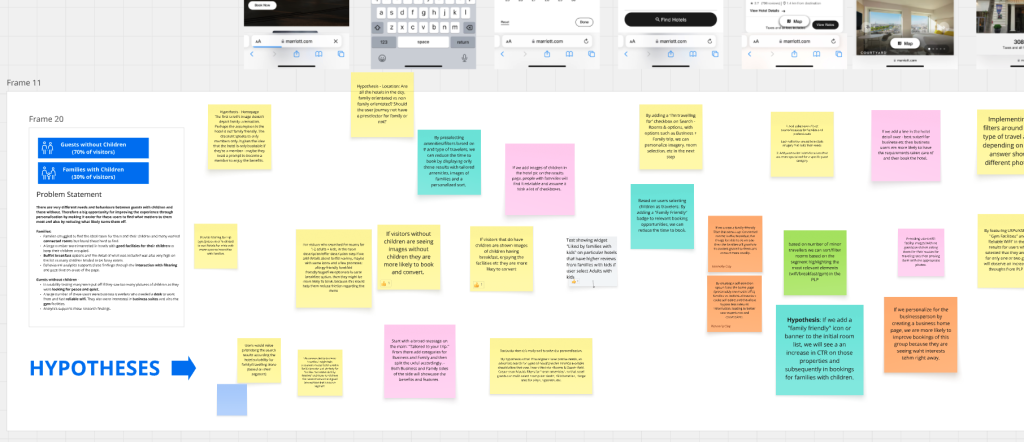
Key Suggestions Included:
- For guests with and without children: Suggestions like reprioritising homepage imagery and preselecting filters based on traveller types aimed to streamline the experience while accommodating diverse needs.
- For members vs non-members: Ideas such as offering perks like free cancellations to boost sign-ups showcased how personalisation can drive engagement while being mindful of broader user needs.
- For new vs returning visitors: strategies like recalling past searches or displaying shortcuts for returning visitors highlighted the value of making repeat journeys faster and more intuitive.
Next Steps
Now, if this were a real project here would be your next steps:
- Prioritise Hypotheses: Focus on solving the biggest problems for the largest segments, rather than picking ideas based on instinct.
- Design, Test, and Iterate: Build these experiences as experiments with proper controls and A/B testing to validate their impact.
He closed by encouraging a long-term commitment to personalisation: “With the right balance and consistent experimentation, personalisation can deliver significant rewards.”
Conclusion
Chris concluded the workshop by encouraging the attendees to keep the conversation going:
“I’d love to find out more of your challenges with personalisation if you have any, and hopefully today’s session on insights-led personalisation has been helpful and there’s something you can take away from this, get in touch, I’m always on Linkedin so send me a message if you want to chat and we can talk about this some more and go into more detail on the practicalities.”
As we bring our VWO CONVEX 2024 recap series to a close, it’s clear that each session has offered valuable lessons for achieving progress through strategic experimentation. From Primark’s journey into digital experimentation to EasyJet’s Problem-First Prioritisation, each season has highlighted the importance of designing strategies rooted in user needs and addressing real challenges to achieve successful experimentation.
Chris Gibbins’ workshop on personalisation has been a fitting finale, exhibiting how tailored approaches can deliver improved user experiences, and therefore contribute to stronger business performance.
If you’ve been inspired by the topics covered in this mini series, or would like to discuss how they can be applied, we’d be happy to help. Get in touch with Creative CX to continue the conversation.
